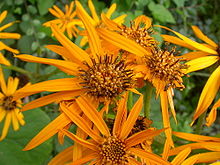
I have a space in a shady part of the garden where nothing succeeds except hellebores, and a “volunteer” privet shrub that is the offspring of the line of privets that bounds the front of the garden. This semi-dead zone is probably semi-dead because of its proximity to a middle-aged maple tree that sucks up most of the moisture and nutrients in the soil. Every autumn the area is inundated with fallen maple leaves, and the rest of the time it is afflicted with tiny maple seedlings. I spend hours raking up the leaves, grubbing out the seedlings and meditating on why plants collapse and die at the mere sight of this difficult spot.
What is the answer to this dead zone conundrum? It might be more hellebores, which are tough, deer resistant and bloom for six weeks in the spring. I could add in some of the large-leaf hostas, which survive almost anything, except slugs and hungry deer. I could resort to hostas, deer spray and slug bait, but I also crave fall interest, especially late summer and early fall flowers. Asters would be perfect, but even the redoubtable ‘Alma Potschke’ aster grows spindly in that space and produces few flowers.
I considered defaulting to annuals, popped in and out at opportune times and regularly renewed with new plants throughout the growing season. This is a good strategy if you have lots of money, water religiously and remember to change out the annuals before they become stringy and uninspiring. I do not have that much faith in myself.
I get my best ideas when I am either out walking or in the shower. I was stepping smartly through one of the streets near my house when I sighted something that might bring the dead zone to life—a shade-tolerant perennial called ligularia.
The ligularia I saw was most likely Ligularia dentata ‘Britt Marie Crawford’, a variety with large, rounded, toothed leaves that are bronze-purple on the undersides. My neighbors’ ligularia was obviously happy and had formed large clumps in a shaded bed. In flower, the plants were about three feet tall, and sported clusters of orange-yellow daisies. The combination of dark green, purple and orange-yellow lit up the bed. I wondered if the plants could do the same in my dead zone.
Ligularia gets its Latin name from “ligula” which means “strap”. In this case, the “strap” is the elongated petals on the daisies. The notorious Roman emperor, Gaius Julius Caesar Augustus Germanicus, known to the world as Caligula, allegedly got his nickname from the same root. Caligula’s parents frequently dressed the young emperor-to-be in miniature Roman army garb, complete with strapped sandals. Clearly the straps did nothing to improve Caligula, but the small strap-like petals of ligularia have a lot of garden potential.
The most popular ligularia are ‘Britt Marie Crawford’ and another dentata, ‘Desdemona’, with leaves that are brown-bronze on both sides. Almost equally celebrated, Ligularia stenocephala ‘The Rocket’, grows up to five feet tall and four feet wide, with the same rounded, toothed foliage. ‘The Rocket’ takes off from a base of green leaves that lack the distinctive purple undersides of ‘Britt Marie Crawford’. With daisy flowers that are born in showy spikes instead of simple clusters, ‘The Rocket’ provides a somewhat different garden profile than its less vertical relatives. All three ligularia bloom in late summer.
Clearly, the statures of ‘Britt Marie Crawford’ and ‘The Rocket’ dictate that they be used as mid or back of the border plants, depending on the size of the garden. Both could grow in very large pots as well, but would probably need to be decanted and divided every few years. If your space is more confined, try ‘The Rocket’s offspring, ‘Bottle Rocket’, which grows only 2.5 feet tall and wide, but boasts the same showy leaves and flower spikes as its parent.
Some shade gardeners whine incessantly about the lack of blooms in their planting schemes. If you consider yourself shade-afflicted, ligularia, also sometimes known as “leopard plant”, can offer flowery salvation. The only caveat is that the plants cannot abide dry shade. If they are not kept consistently moist, they droop alarmingly and die relatively quickly. I know this because it happened to me.
Now I am a wiser gardener. Should I choose ligularia to liven up all or part of the dead zone, I will also invest in a soaker hose to keep it damp and comfortable. Of course, the added moisture will also make the nearby privet hedge grow with wild abandon and may even promote rapid development of the maple seedlings, but all gardeners have to take the bitter with the sweet.
Ligularia is a genus of about 150 species, all but a few of which are native to parts of Asia. The genus was named by Alexandre Henri Gabriel Cassini, an early nineteenth century French botanist who specialized in the daisy family. Some ligularia species, like the tongue-twisting Ligularia przewalskii and the cultivars ‘Osiris Fantasie’ and ‘Dragon’s Breath’, are grown primarily for their colorful, showy leaves, rather than the yellow-orange flowers they share with other members of the genus. While not as popular as ‘The Rocket’, they are available from specialist nurseries.
Nature and I both abhor bare ground, so I will make a decision about ligularia and my dead zone within the next week. First, I will eliminate the volunteer privet, which is clouding my vision of the space. Then I will fill it with something a lot more satisfying.
Find a selection of ligularia at ForestFarm, 14643 Watergap Rd, Williams, OR 97544;
(541)-846-7269; www.forestfarm.com. Free print catalog.
